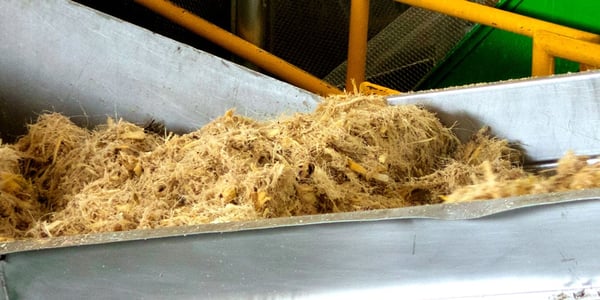
En mis diez año
In my ten year’s experience in the Tequila Industry, I've noticed that some of the most frequently asked questions are What environmental impact is the waste (generated in the tequila industry) generating? And What is Casa Sauza doing to avoid contaminating? In the first place, I think is convenient to understand some concepts before we talk about this subject in more detail and give answers to these interesting questions.
Waste Classification in the Industry
Definition: It exists a general agreement in the definition of “waste”, according to the federal and the state legislation, and in this case, both of them say that it is: “Any material or product that is disposed by its owner, and is a solid, semi-solid, liquid or gas, contained in reservoirs or deposits, including the fact that it must require a treatment or final disposition…”
Waste Classification
From this point, many interesting concepts arouse: How is waste classified by the Law? and How does the Law classify waste generators? Starting from here, we can say that Law indicates that waste is classified in three different categories:
- Dangerous Waste: Are all those elements that contain certain characteristics of corrosiveness, reactivity, explosivity, toxicity, flammability, or that that may contain infectious agents which turn them into dangerous products. This includes as well all the packages, bottles, vessels, containers and even the land that may have been polluted in any transfer process.
- Special Management Waste: We refer to all the waste that was generated during the production processes and they don’t meet the features to be considered dangerous or solid urban waste.
- Solid Urban Waste: These are generated at homes, and are the result of different material’s disposal which is used in domestic activities. Products that were consumed and then their packages are thrown away are also part of this classification. They may come also from inside the plant facilities, public spaces, and parking lots.
Waste Generators Classification by Mexican Law
Mexican Laws and Policies classify waste producers/generators in three categories:
- Micro-Generator: Industrial, commercial or service Establishment that generates no more than 400 kg of dangerous waste per year, or its equivalent in any other measurement unit.
- Small-Generator: Natural or legal person who generates an amount equal to or exceeding 400 kg, but less than 10 tons in total gross weight per year, or its equivalent in any other measurement unit.
- Big-Generator: Natural or legal person who generates an amount equal or exceeding 10 tons in total gross weight per year, or its equivalent in any other measurement unit.
Who Regulates Waste Generators in Mexico?
The dangerous waste generators, belonging to any of the three categories mentioned above are regulated by federal laws and official standards. They have to meet the Secretaría de Medio Ambiente y Recursos Naturales (SEMARNAT) and Procuraduría Federal de Protección al Ambiente (PROFEPA) requirements.
On the other hand, the special management waste generators are regulated by state laws, and at least in Jalisco, they are compelled by Secretaría del Medio Ambiente y Desarrollo Territorial (SEMADET) regarding the authorization processes, and finally when watching and supervising the treatment procedures, Procuraduría Estatal de Protección al Ambiente (PROEPA) is the organization in charge.
Solid urban waste fall within the competence of each municipality, and this would be the entity in charge of regulating them. Understanding waste and generators classifications it’s easier to visualize the dimensions of this problematic.
In the case of the Tequila Industry, both dangerous and special management waste are generated. They come principally from the equipment maintenance processes (industrial trash contaminated with hydrocarbon and/or solvents, oils, empty containers which had these substances, lubricating greases, etc.), in a volume that can vary from a micro-generator to a big-generator amount. In our Industry, the special management waste has the highest volume, turning almost every Tequila Industry into a big-generator.
What kind of Waste Does the Tequila Industry Generate?
A wide variety of waste exist in the Tequila Industry, however, the two main residues are bagasse and vinasses. To better dimension this situation, in the year 2014, approximately 240 thousand tons of bagasse were generated, which is the equivalent of a 20 days waste generation in the metropolitan area in Guadalajara. Additionally, 1.6 million cubic meters of vinasses were generated, which is equal to the wastewater production by a population of 21,000 individuals during a year. So, we know the environmental problem is looking kind of big.
The bagasse is the agave fiber leftover we have once we have finished extracting the sugar from it. Even though is an organic residue and its considered biodegradable, if it’s not properly managed, it can last for a long period of time without discomposing and reintegrating its components to the soil.
In this uncontrolled discomposing process, the main issue is that bagasse produces leachates (residual toxic liquids) which contaminate soil and water, changing its natural characteristics, they also generate bad odors that pollute the air and proliferate plagues that may become health problems or diseases.
When talking about the vinasses in the Tequila Industry, we can say that they are the residual water that comes from the distillation process and they have high solids concentration (ST), above 21,000 mg/l and a low pH between 3.5 and 3.9. This means that if they are disposed of in the soil or a body of water without a proper treatment, these may contaminate the environment, eliminating life and natural balance. That’s why is so important to correctly manage this kind of waste.
If you want to know what other options we have implemented in Casa Sauza to take care of the environment, I invite you to read the following articles:
- Options for Waste Treatment in Tequila Industry
- Sustainable Waste Management in Tequila Sauza
- Wastewater Treatment in Tequila Sauza
Come and visit Casa Sauza so you can learn how the modernization of our production processes deliver the purest tequila that you will find in the market.
.png?width=50&height=50&name=10.CS-Redondo%20(1).png)
